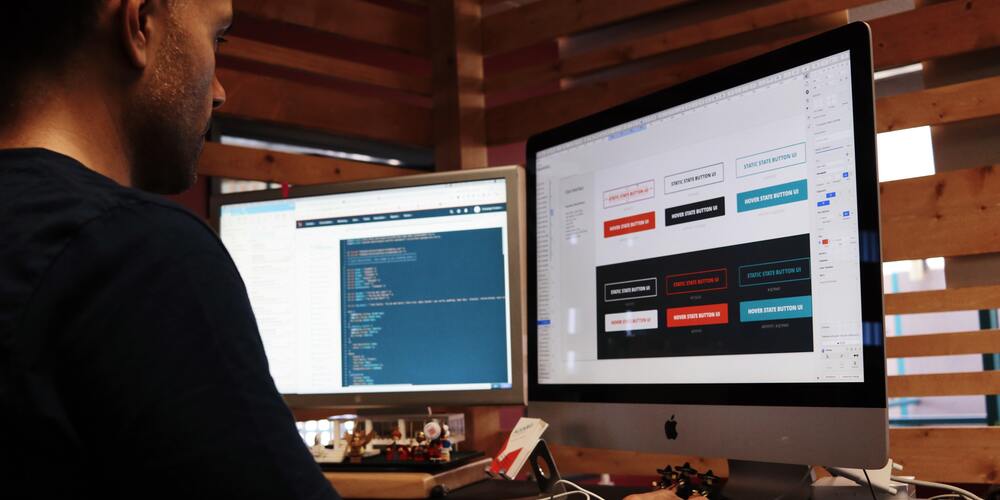Building your brand’s website is a big deal. It’s where you’ll showcase your products or services, connect with potential customers and maybe even close sales (depending on your business model). So, naturally, you want to make sure it’s perfect both for your brand and your audience.
There are many different considerations when building a website, but in this blog, we’ll stick to the very first, most basic decision: custom or template?
To help me break it down, I’ve pulled in some of our resident experts: Amanda Sleger (Director of Sales and Marketing), Vanessa Wolfe (Design Team Lead) and Kylee Bustamante (Jr. Web Developer). Throughout this article, they’ll give their professional insights and recommendations to help you assess your business’ needs and choose the type of website that will work best for you.
Here’s a quick look at what we’ll tackle in this post. Let’s get started!
What’s the Difference?
This question is at the heart of most business owners’ consternation when they’re asked, “Do you want a template or custom website?” But don’t worry, what separates the two is actually pretty straightforward.
Templated websites come preprogrammed with things like formatting and style, so all you have to do is plug in your colors and copy and you’re ready to go! Custom sites allow you to play with all the elements of your website to create something truly unique.
Our Director of Sales, Amanda, has a helpful way of looking at it: “A templated site is like going to a general contractor to build your house. They’ll have a few different floor plans you can choose from and some choices from finishes, but your house will look similar to everyone else’s in the neighborhood.
“A custom site is like going to an architect and having them draw up something to fit your specific needs. Then you meet a contractor and they’ll draw up the plans for the builder.”
And just like building a custom house, your custom site requires a heftier team too. But we’ll get to that later on. Now, let’s take a closer look at templated websites, what they can do and how fast you can get one up and running.
Templated Websites
Templated websites are great for businesses with a tight budget or on a short timeline. They work well when you need a simple site with minimal designs and just a few web pages.
“One of the biggest advantages of using website templates is that most of the code is already written, so it’s a quicker way to get a site up and running,” Kylee notes. This is often a huge benefit for businesses that need a quality site on a short timeline.
The Team
Every website design project benefits from having a project manager on board. Whoever is in this role will make sure the project stays on track, your feedback is implemented throughout and all necessary revisions are made.
You’ll also be working closely with a designer, who will create your website wireframe, implement your brand colors and insert copy. In short, the designer will take a bare template and make it come alive in your brand’s image.
For these sites, Kylee says developers aren’t always necessary. “Developers work on templated sites more to make sure best practices are in use than to make changes to the code itself,” she explains.
Capabilities
A big draw of templated sites for businesses is that most of the heavy lifting is already done. Templates often use modular designs that make it super easy to plug in your logo, images, colors and copy into the site.
“Modular is good because it’s super quick and you don’t have to think about a lot of the design elements,” Vanessa says. “But the drawback is that if something isn’t quite working or you want to adjust the design, you’re pretty limited as to what changes you can make.”
On the development side of things, templated sites have some powerful capabilities through plugins. Plugins are pieces of software that add functionality to your website. WordPress is pretty popular for offering a wide variety of plugins that can do everything from checking your site’s SEO to scanning for security concerns. These are one way to get some custom(ish) features on a templated site.
There are some plugin horror stories out there that might have you worried about using them extensively on your site. Yes, plugins can impact your site performance for the worse if they’re used or implemented incorrectly. But this doesn’t mean using them is always a bad idea.
Kylee notes that if you have help from a knowledgeable developer, that person can ensure the plugins you use will run smoothly. This can preserve your site’s performance while also giving you the functionality you want.
Instead of plugins, she says the biggest development drawback of working with a template actually comes when you want to make changes that weren’t already in the code. Kylee explains that developers don’t have much control over the code quality in a web template, which means it may be difficult to make modifications to foundational elements.
Timeline
Plenty of businesses opt to use a website template simply because it’s faster. You can get a templated website up and running in a matter of weeks, where custom sites can take months.
“The timeline is mostly about how long it takes to get all your information onto the page,” Vanessa notes.
For example, at Lone Fir, our 5-page, StoryBranded template sites typically take about 30-45 days to complete.
But how long it takes to build a website can vary greatly. It depends on how many pages you need, if you have all the content for the site ready and how much planning you’re willing to put in. (Hint: You shouldn’t skip the planning process!)
Cost
Perhaps the main reason templated websites are so popular is because they’re more affordable than custom sites.
The cost is based on a many factors, including:
- Number of web pages
- What platform you use
- Level of detail on the template
- Which plugins you add (not all of them are free)
“The biggest benefit of templated sites is they give businesses with smaller budgets access to professional websites that can meet all their needs,” Amanda says.
She adds they’re also a cost effective option for brands that simply don’t need a complex website. “At times it makes sense to spend less money on your site and more on other lead generating or converting efforts.”
Custom Websites
Anyone who works on websites could probably wax poetic on the intricacies of a custom site. But that’s just not our style. Instead, Amanda puts it concisely: “Custom websites are good for brands with complex service or product offerings that need to provide a lot of education throughout their sales process.”
She notes businesses with these needs might require a large resource library with filtering capabilities or advanced functionality, or even a unique user experience and design to properly convey their brand. Custom sites can accomplish this in ways a templated site can’t.
Aside from meeting your business needs, custom sites also give you more control over the visual aspects of your website.
“If you have the budget and you like to be in control of the way things look, you’ll probably be happier with a custom design,” Vanessa says.
So now that we have the basics down, let’s take a closer look at the pros and cons of a custom website.
The Team
Just like with a templated site, you’ll have a project manager and web designer working on your custom website. The difference is that your web developer will have a much bigger role.
The developer on your team will work on the actual building of your site. They’ll be writing code, laying out the foundation and helping with the eventual launch of your site.
One bonus of building a custom website with an agency is that your developer can maintain your site post-launch too. If you continue your partnership with whoever built your site, you can trust them with the ongoing maintenance and changes too. Kylee notes this often means quicker and better results than tinkering with a template’s code.
Capabilities
When it comes to what your custom site can do, the sky’s the limit. “There’s nothing limiting you when it comes to custom sites,” Kylee says. “Pretty much anything you want, you can make happen.”
Design
Vanessa agrees, adding that it can also help you stand out from crowded competition. “You have so much more capability to play with color, layout and movement to create a truly memorable website.”
If you’re like me, you might be wondering what Vanessa means by “movement.” She’s not talking about just scrolling up and down the page—it’s something much cooler. The example she used was animated logo designs. On a custom site you can add animations to any graphic design element to create an overall more dynamic experience for the user.
Check out Panic Studio’s site to see what she’s talking about.
Development
The freedom in development is one of the biggest pluses to working with a custom website. This section could be a blog in its own right, but Kylee helpfully narrowed down custom website development into three main points:
- Performance – “With the improved code quality on a custom website, you have a lot more control over its performance,” she says. She notes site load time and smoother integrations as two of these performance factors.
- Scaling – As your business grows, your website will inevitably need some changes. When you have a custom website, it’s much easier for the developers to go back and make edits because they know the code. This means they can find and fix issues quicker as well as help you expand your site with ease.
- Web accessibility –The move toward web accessibility across all websites has many people wondering if theirs fits the bill. Kylee says one good thing about a custom website is that you can bake accessibility right into the code. “We can maintain accessibility at launch and over time more than on a templated site. This makes it easier for the content editors to stay within the bounds of accessibility guidelines.”
Sales
Custom websites also give you the opportunity to craft user flows that support your sales process and the buyer’s journey. Amanda notes that templated sites have limited ways of displaying information, which can limit your abilities to explain a complex buyer journey.
“The key is to first analyze and understand your buyer’s journey and how it should look on your website,” Amanda notes. “You can make a lot more updates and edits to how content is displayed on a custom website, but you want to make sure it’s supporting your user.”
She recommends always arranging information in a very easy-to-digest way, no matter what type of website you have.
By now you might be wondering why everyone doesn’t opt for a custom site? With all these capabilities it might seem like an obvious choice, but there are some big trade-offs to access these perks.
Timeline
The first tradeoff is your timeline. Custom websites take significantly longer to develop than templates because you’re starting from scratch. Instead of plugging information into an existing layout, you’re literally building from the ground up. Your designer will have to figure out the layout and all of the visual elements, then your developer will create the code to support them.
For this reason, custom websites tend to take months to develop. At Lone Fir, we usually quote 3-4 months for a custom website. And if the required development is more complex, then it usually ends up falling closer to the 4-month mark.
Just like with construction projects in the real world, there are a number of factors that can cause delays in your web build. Vanessa and Kylee mentioned two of the most common factors that can slow down a project:
- Existing design elements. Vanessa notes that if you’re a brand starting from scratch without any existing design elements—logo, mood board, brand colors—then you might have to build in more hours for the design team as they create those things for you.
- Finalized content. Kylee reminds us that for development to finish creating a website, they need the content to put into it. So if there are any delays with revisions or finalizing copy and design, that could slow down your build too.
Cost
The cost of a custom website design is probably the biggest barrier to entry for businesses. The final price tag is highly dependent on a number of factors like number web pages, interactive or custom features, the length and detail of the design process and whether you want ongoing maintenance post-launch.
For the right business, though, the money can be well worth the investment. “Custom sites are worth spending the money when you really want to stand out and be different,” Vanessa says. “When you want to have that authority of your brand looking and feeling unique instead of just another template.”
What’s Best for My Business?
Okay, that was a lot of information! Before we push ahead, let’s do a quick recap of the pros and cons:
|
Templates |
|
|
Pros |
Cons |
|
Easy to set up and maintain |
Limited capabilities |
|
Faster production time |
Not much control over layout |
|
Low cost |
Lacks uniqueness |
|
Custom |
|
|
Pros |
Cons |
|
Custom functionality |
Likely to require maintenance |
|
Improved performance |
Lengthy timeline |
|
Stand out from competitors |
High cost |
In general, Amanda says she often recommends templated websites to potential customers. “Unless they’re looking for a very specific functionality or have a reason for needing a custom website, our templated sites can usually meet their needs and their budget.”
Vanessa adds to that sentiment, “If someone is using your site mainly for information purposes, then a template will work just fine. You don’t need all the bells and whistles.”
If you’re in a crowded market with lots of competition, that’s a different story. In that case, Vanessa advocates for custom web design. “If you’re in a space where you’re selling against some big established name brands, then I’d recommend a custom site,” she says. “You need to be loud enough in that space to be different, and vanilla templates just won’t get the job done.”
Even knowing the pros and cons, you might still feel unsure of what’s right for your business. That’s okay. Amanda recommends thinking through two things to determine your best fit:
- What are your long-term goals? A small business looking to scale and a big company maintaining clients will need two different websites. You want to make sure whatever site you choose has the capabilities you need now and in the future, so you can make adjustments instead of having to rebuild the whole thing.
- What’s your budget? The price difference between templated sites and custom sites is stark, so this is often a deciding factor for brands. Keep in mind that templated sites still have some pretty advanced capabilities, so depending on your needs, they’re a good way to get some bang for your buck.
(P.S. — If you need more help deciding, we’re always happy to hop on a call.)
The Choice is Yours
So there you have it. Everything you need to know (and probably a little more) about templated and custom designed websites. What it all boils down to: pick the format that meets your business’ needs and goals. For the most part, a template can do that. But if you need something special to spice up your site, consider custom!
We get pretty pumped about web design here at Lone Fir, and we love sharing our knowledge. So if you want to learn more on this topic, check out our blog about Growth-Driven Design!








